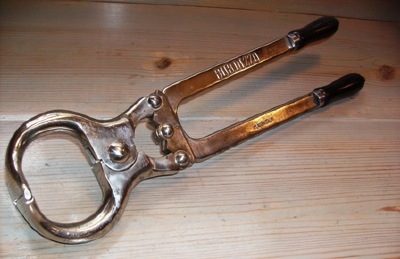 Four small meadows surrounded the cottage we lived in when I was a child. Each summer these fields provided a hay harvest. My earliest memory of the process is of using wooden rakes and twin-tined pitchforks, or pikes as they were called, to gather the hay into piles called cocks. A horse drawn cart would then arrive and hay from the cocks was lifted with the pikes onto the cart. The final destination for the hay was the dutch barn in a corner of the meadow closest to the cottage. In later years the cart would be drawn by a small Fordson tractor. Behind the cart a mechanical loader lifted hay from the swathes and deposited it onto the cart.
Four small meadows surrounded the cottage we lived in when I was a child. Each summer these fields provided a hay harvest. My earliest memory of the process is of using wooden rakes and twin-tined pitchforks, or pikes as they were called, to gather the hay into piles called cocks. A horse drawn cart would then arrive and hay from the cocks was lifted with the pikes onto the cart. The final destination for the hay was the dutch barn in a corner of the meadow closest to the cottage. In later years the cart would be drawn by a small Fordson tractor. Behind the cart a mechanical loader lifted hay from the swathes and deposited it onto the cart.
Once we moved to the former Manse I would spend Easter and summer school holidays doing casual labour on a large farm a mile to the north-west of the village. These days it is common to see young men and women from Eastern Europe doing farm work in England. It might surprise some to learn that, on this particular farm on the border between England and Wales, in the late 1950s, there was a Polish refugee working alongside a German former prisoner of war. They, and their English wives and children, lived in adjacent farm cottages.
I remember picking potatoes, cutting thistles, and something called ‘rogueing’. This involved walking through a field of wheat, pulling out wild oats. These ‘rogues’ were stuffed into sacks and carried to the field entrance. I also remember more hay-making, this time using a pitchfork to lift bales onto a cart, then, later, arranging the bales in the barn. The higher the stack became, the closer to the corrugated steel roof one worked. The heat and dust became over-powering.
Although I have always been physically small, never weighing much more than 130lbs, I enjoyed physical labour. I still do. Your back might ache, your muscles burn, your hands smart, sweat stream from every pore. Nevertheless there is something exhillerating about the experience, unmatched by anything else.
Castration
 By far the most unpleasant task I had to perform took place one Easter holiday. I had to assist the fellow who had been engaged to castrate and dock the tails of that year’s new lambs. We worked in a small enclosure constructed from straw bales. My job was to capture the untreated lambs, one by one. I would then sit on a bale facing the contractor, holding the lamb against my body with the animal’s tail and genitals exposed to the man opposite. This gentleman would then use a sharpened pen-knife to cut through the tail, cauterising the wound with an iron instrument which was kept hot in the flames of a Primus stove. He would then use another specially designed instrument to remove the other appendage. This wound was treated with an ointment that, to me, resembled the grease used on the farm’s machinery. The cries of the lambs and the acrid smell of burned flesh still live with me 60 years later.
By far the most unpleasant task I had to perform took place one Easter holiday. I had to assist the fellow who had been engaged to castrate and dock the tails of that year’s new lambs. We worked in a small enclosure constructed from straw bales. My job was to capture the untreated lambs, one by one. I would then sit on a bale facing the contractor, holding the lamb against my body with the animal’s tail and genitals exposed to the man opposite. This gentleman would then use a sharpened pen-knife to cut through the tail, cauterising the wound with an iron instrument which was kept hot in the flames of a Primus stove. He would then use another specially designed instrument to remove the other appendage. This wound was treated with an ointment that, to me, resembled the grease used on the farm’s machinery. The cries of the lambs and the acrid smell of burned flesh still live with me 60 years later.
I am sure that such tasks continue to be part of the annual cycle of farming practices. I am equally sure that those performing them do so in a much more hygienic and humane manner.
Have you ever worked on a farm? Perhaps you are a farmer, or worked on the land in vacations whilst studying. Do share your experiences in the comments.

Reading about castration was disturbing, but it’s interesting to read about how farming was done (even that part). I hope it’s better now, but that doesn’t seem to be the case with factory farms.
LikeLike
Agree with your view of factory farms. At least back then the animals were free range out doors with access to grass. And in the meadows around the cottage in the ’50s the grass included a lot of herbage that would be regarded aw weeds today but which added both to the attractiveness of the meadow and the variety of the animals’ diet.
LikeLike
I milked a cow once and that was enough for me. Me and farms don’t tend to gel, plus the fact the ‘rustic’ smells always make me want to retch!
LikeLike